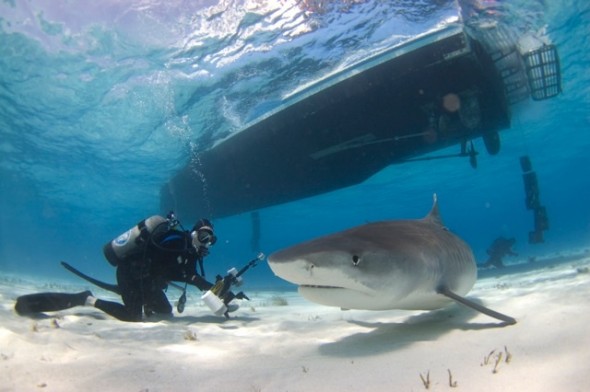
I still remember the first time I saw a shark. It was in Belize, on Turneffe Atoll. I’d been waiting for it for weeks, keeping my eyes peeled for fins, until finally there it was – a great big nurse shark, snoozing peacefully on the seabed, 10 meters below me. It was every bit as awesome as I’d hoped it would be.
And obviously I’m not alone in wanting to scuba dive with sharks. Sharks are big business these days and another study has just come out underlining just how valuable they can be alive and swimming around instead of dead and made into soup.
To get a handle on the scale of shark diving globally, Austin Gallagher and Neil Hammerschlag did what any of us could do (but hadn’t thought of doing) – they went to the internet and searched for companies offering shark-related dive experiences. And they came up with some impressive and interesting stats.
Using a bunch of different search terms they found 376 operators in 83 locations spanning 29 countries. Sharks are clearly all the rage.
Top ranking shark-spotting countries include the Bahamas (which alone clocks up 70% of shark ecotourism in the Greater Caribbean) and the Maldives where live sharks raise an estimated one third of their GDP.
The most popular sharks advertised were reef sharks (various species bundled together), whale sharks, and scalloped hammerheads (a species I’ve still not seen – shame on me!).
So, if you’re into your shark encounters and want to know where to go next, don’t bother trawling around the internet… these guys have done it all for us.
Gallagher and Hammerschlag point out a shark dichotomy. Every day that a shark stays alive and available for divers to catch a glimpse of, it raises an average $73 in tourism revenue. That compares with the average market price tag for a dead shark – fins, meat, and all – of around $50. And don’t forget, you’ll only get that payoff one time per shark.
They also give an in-depth analysis of one particular shark operation, a great white shark outfit in South Africa, showing how business has boomed over the past decade. What they don’t do is mention whether chumming is involved – and since I just finished reading Susan Casey’s homage to Californian great whites The Devil’s Teeth, I’m feeling a bit edgy about feeding sharks to see them.
Anyway, I think we’ve now conclusively made the case that keeping sharks alive creates more money than killing them. but the big question is how long until that message gets through and the killing stops?
Any takers for that brainteaser?
Gallagher and Hammerschlag’s paper is published in Current Issues in Tourism.
Leave a Reply